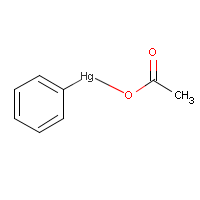Phenylmercuric acetate
Agent Name
Phenylmercuric acetate
CAS Number
62-38-4
Formula
C8-H8-Hg-O2
Major Category
Metals

Synonyms
(Acetato)phenylmercury; (Acetato-O)phenylmercury; (Acetoxymercuri)benzene; Acetate de phenylmercure [ISO-French]; Acetate phenylmercurique [French]; Acetic acid, phenylmercury deriv.; Acetic acid, phenylmercury(II) salt; Acetoxyphenylmercury; Agrosan D; Agrosan GN 5; Algimycin 200; Anticon; Antimucin WBR; Antimucin WDR; Benzene, (acetoxymercuri)-; Benzene, (acetoxymercurio)-; Bufen; Bufen 30; Cekusil; Celmer; Ceresol; Contra Creme; Dyanacide; Femma; Fenylmercuriacetat [Czech]; Fenylmerkuriacetat [Czech]; Fungicide R; Fungitox OR; Gallotox; Hexasan; Hexasan (fungicide); Hl-331; Hong nien; Hostaquick; Hostaquik; Intercide 60; Intercide PMA 18; Kwiksan; Liquiphene; Lorophyn; Meracen; Mercron; Mercuriphenyl acetate; Mercuron; Mercury(II) acetate, phenyl-; Mercury, (acetato)phenyl-; Mercury, acetoxyphenyl-; Mergal A 25; Mersolite; Mersolite 8; Mersolite D; Metasol 30; Neantina; Norforms; Nuodex PMA 18; Nylmerate; Octan fenylrtutnaty [Czech]; PMA; PMA (fungicide); PMAC; PMAL; PMAS; Pamisan; Panomatic; Parasan; Parasan (bactericide); Phenmad; Phenomercuric acetate; Phenyl mercuric acetate; Phenylmercuriacetate; Phenylmercuric acetate; Phenylmercury acetate; Phenylmercury(II) acetate; Phenylquecksilberacetat [German]; Phenylquecksilberacetate; Phix; Programin; Purasan-SC-10; Puraturf 10; Quicksan; Quicksan 20; Riogen; Ruberon; Samtol; Sanitized SPG; Sanitol; Sanmicron; Sc-110; Scutl; Seed Dressing R; Seedtox; Setrete; Shimmerex; Spor-Kil; Spruce Seal; Tag; Tag (VAN); Tag 331; Tag HL 331; Tag fungicide; Trigosan; Troysan 30; Troysan PMA 30; Verdasan; Verdasan (VAN); Volpar; Zaprawa Nasienna R; Ziarnik; UN1674; [ChemIDplus]
Category
Metals, Organic Compounds
Description
White or white-yellow crystals (hygroscopic); [ICSC]
Sources/Uses
Has been used as a preservative for contraceptive gels and foams; a paint biocide; an instrument disinfectant; a mildewcide for leather, ink, adhesives, tape muds, and caulking compounds; an eyewash preservative; a slimicide in paper mills; a fungicide for crops; a herbicide; an aquatic parasiticide; and a catalyst in the manufacturing of polyurethanes; [HSDB]
Comments
Immunologic, occupational contact urticaria documented; [Kanerva, p. 219] Toxic by ingestion, skin absorption, and inhalation of aerosol; Corrosive to the skin; Can injure the kidneys and nervous system; [ICSC] The phenyl mercuric salts (used in herbicides, fungicides, antiseptics, and preservatives) are strong skin irritants and patch testing is difficult. [Marks, p. 148] Mercury can produce slight hepatic injury in experimental animals. [Zimmerman, p. 419] See "Mercury, aryl compounds" and linked occupational diseases.
Restricted
Was used as a biocide in interior and exterior paints prior to 1991; [ATSDR ToxProfiles] Not registered for current use in the U.S by the EPA. [HSDB]
Reference Link #1
Biomedical References
Exposure Assessment
Skin Designation (ACGIH)
Yes
Bioaccumulates
Yes
TLV (ACGIH)
0.1 mg/m3, as Hg
PEL (OSHA)
0.1 mg/m3, as Hg
IDLH (NIOSH)
10 mg/m3, as Hg
Vapor Pressure
6E-06 mm Hg
Explanatory Notes
Flash point = 100 deg F; NFPA flammability: 1 for dry material; 2 for solution; For TLV, see "Mercury, aryl compounds." [CHEMINFO]
NFPA
high ambient temp required
Adverse Effects
Skin Sensitizer
Yes
Neurotoxin
Sensorimotor
Reproductive Toxin
Yes
Dermatotoxin
Skin burns
Diseases, Processes, and Activities Linked to This Agent
Diseases
Occupational diseases associated with exposure to this agent:
Processes
Industrial Processes with risk of exposure: